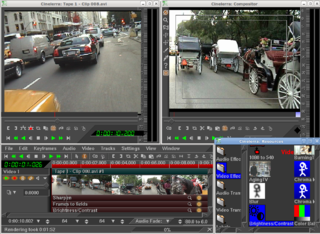Darwin is the core Unix-like operating system of macOS, iOS, watchOS, tvOS, iPadOS, audioOS, visionOS, and bridgeOS. It previously existed as an independent open-source operating system, first released by Apple Inc. in 2000. It is composed of code derived from NeXTSTEP, FreeBSD, other BSD operating systems, Mach, and other free software projects' code, as well as code developed by Apple. Darwin's official mascot is Hexley the Platypus.
Version control is the software engineering practice of controlling, organizing, and tracking different versions in history of computer files; primarily source code text files, but generally any type of file.

Cinelerra is a video editing and track-based digital compositing program designed for Linux. It is free software distributed under the open source GNU General Public License. In addition to editing, it supports advanced composition operations such as keying and mattes, including a title generator, many effects to edit video and audio, keyframe automation, and many other professional functions depending on the variant. It processes audio in 64 floating-point form. Video is processed in RGBA or YUVA color spaces, in 16-bit integer or floating-point form. It is resolution and image refresh rate independent. The GG variant supports up to 8K video, and can also create DVDs and Blu-rays.

Monotone is an open source software tool for distributed revision control. It tracks revisions to files, groups sets of revisions into changesets, and tracks history across renames. The focus of the project is on integrity over performance. Monotone is designed for distributed operation, and makes heavy use of cryptographic primitives to track file revisions and to authenticate user actions.

Git is a distributed version control system that tracks versions of files. It is often used to control source code by programmers who are developing software collaboratively.
In software development, distributed version control is a form of version control in which the complete codebase, including its full history, is mirrored on every developer's computer. Compared to centralized version control, this enables automatic management branching and merging, speeds up most operations, improves the ability to work offline, and does not rely on a single location for backups. Git, the world's most popular version control system, is a distributed version control system.
Open-source software development (OSSD) is the process by which open-source software, or similar software whose source code is publicly available, is developed by an open-source software project. These are software products available with its source code under an open-source license to study, change, and improve its design. Examples of some popular open-source software products are Mozilla Firefox, Google Chromium, Android, LibreOffice and the VLC media player.

Mercurial is a distributed revision control tool for software developers. It is supported on Microsoft Windows, Linux, and other Unix-like systems, such as FreeBSD and macOS.
A kernel is a component of a computer operating system. A comparison of system kernels can provide insight into the design and architectural choices made by the developers of particular operating systems.
The following tables describe attributes of notable version control and software configuration management (SCM) systems that can be used to compare and contrast the various systems.
Quilt is a software utility for managing a series of changes to the source code of any computer program. Such changes are often referred to as "patches" or "patch sets". Quilt can take an arbitrary number of patches as input and condense them into a single patch. In doing so, Quilt makes it easier for many programmers to test and evaluate the different changes amongst patches before they are permanently applied to the source code.
Nix is a cross-platform package manager for Unix-like systems, and a tool to instantiate and manage those systems, invented in 2003 by Eelco Dolstra.
Unity Version Control is a cross-platform commercial distributed version control tool developed by Códice Software for Microsoft Windows, Mac OS X, Linux, and other operating systems. It includes a command-line tool, native GUIs, diff and merge tool and integration with a number of IDEs. It is a full version control stack not based on Git.
In version control systems, a repository is a data structure that stores metadata for a set of files or directory structure. Depending on whether the version control system in use is distributed, like Git or Mercurial, or centralized, like Subversion, CVS, or Perforce, the whole set of information in the repository may be duplicated on every user's system or may be maintained on a single server. Some of the metadata that a repository contains includes, among other things, a historical record of changes in the repository, a set of commit objects, and a set of references to commit objects, called heads.

Zephyr is a small real-time operating system (RTOS) for connected, resource-constrained and embedded devices supporting multiple architectures and released under the Apache License 2.0. Zephyr includes a kernel, and all components and libraries, device drivers, protocol stacks, file systems, and firmware updates, needed to develop full application software.

Genode is a free and open-source software operating system (OS) framework consisting of a microkernel abstraction layer and a set of user space components. The framework is notable as one of the few open-source operating systems not derived from a proprietary OS, such as Unix. The characteristic design philosophy is that a small trusted computing base is of primary concern in a security-oriented OS.
In version-control systems, a monorepo is a software-development strategy in which the code for a number of projects is stored in the same repository. This practice dates back to at least the early 2000s, when it was commonly called a shared codebase. Google, Meta, Microsoft, Uber, Airbnb, and Twitter all employ very large monorepos with varying strategies to scale build systems and version control software with a large volume of code and daily changes.

OpenHarmony is a family of open-source distributed operating systems based on HarmonyOS derived from LiteOS, donated the L0-L2 branch source code by Huawei to the OpenAtom Foundation. Similar to HarmonyOS, the open-source distributed operating system is designed with a layered architecture, consisting of four layers from the bottom to the top: the kernel layer, system service layer, framework layer, and application layer. It is also an extensive collection of free software, which can be used as an operating system or in parts with other operating systems via Kernel Abstraction Layer subsystems.






